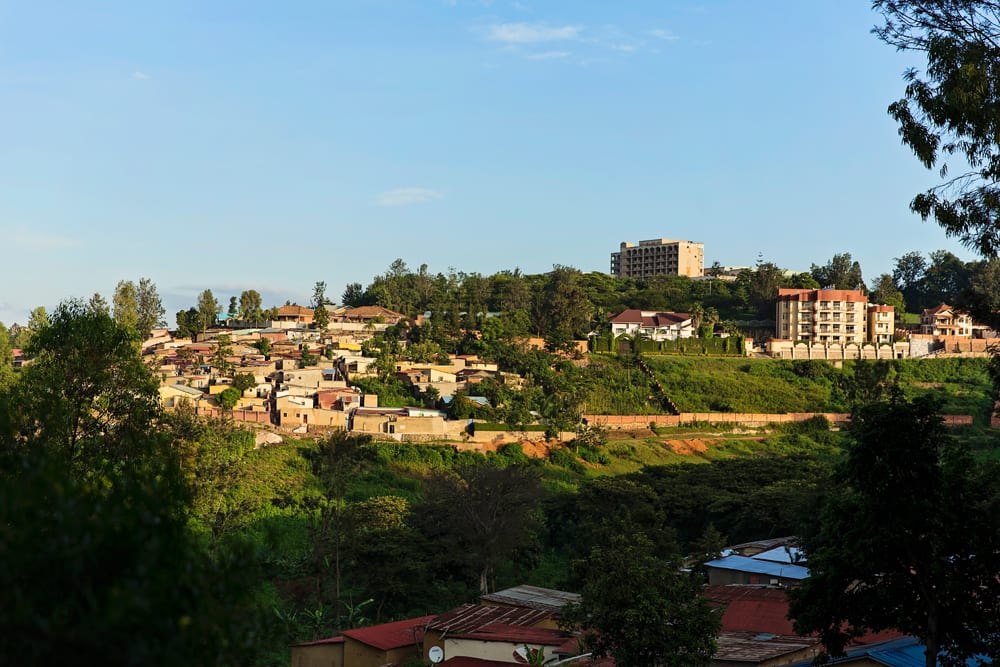Nov 30
When we first landed, we had the usual problem: plan A (get bus into city) got changed (it started to pour), which led to plan B (get taxi), which led to us being slightly taken advantage of and a bit overcharged. It’s a little hard to push past that when the budget is so tight, but we always learn fast and keep it from happening later, and have had much greater success on day two.
We’re staying at Discover Rwanda Hostel and, after waking to the musical gunshot sounds of bathroom doors slamming and the realisation that I’d had an involuntary chiropractic intervention in my sleep, have decided that Rwandan backpacker options provide Southeast Asia standards for North American prices and apparently there’s a global franchise of the Hard Mattress Superstore that I didn’t know about. Yikes. The good news: there’s quite a bit of seating in the lounge areas, exceptionally polite staff, and clean rooms that have a distinctly colonial-era feel courtesy of wide floorboards, big windows, and high ceilings.
Our first experience with Kigali led us both to ask, “Where’s the rest of it?” That would be because these two geniuses set off into the city without the map. Rocket scientists. Here’s the thing, though, about a city built on hills: when the main road runs in the valley, it’s impossible to know what you’re missing on the ridge above. Turns out, we didn’t actually miss a whole lot; it’s just a very simple city trying to get on with life.
Kigali is a city of profound contrasts. Verdant, green, relentlessly undulating hills are dotted with farming plots and tin-roofed homes – some modest houses, some simple shanties – that make the city feel like it runs a little further down the “shabby” end of the shabby-chic spectrum. We arrived in the rain and the day stayed fairly overcast, making our surroundings seem drab, poor… very “Third World” (which it is – thank you, Captain Obvious). Now, as I sit on the veranda at the hostel and look out over the valley below me, the sun is hitting the buildings on the hillside opposite and they are aglow with rich late-day sunlight and the valley below is the deep green that signas healthy crops. The centre of town has that gritty feel of African commerce in action: road dust carries itself along from one parcel to the next, while shopowners stand at the doorways and watch traffic pass by. The one detail that was immediately clear (and that hasn’t changed with the weather) was how clean this place is (apart from the dust of the city centre). This may or may not have something to do with the fact that we arrived an hour after the finish of this month’s umuganda, when the whole country spends 3 hours on the last Saturday of every month working on community projects. I can’t help but think (or hope) that our own cities would be much cleaner if everyone knew that they were just going to have to pick up that litter during their community gardening efforts at the end of the month.
You can’t visit Rwanda without confronting the country’s bloody history in some way: there are visible reminders in the form of scars, damaged bodies, USAID and other foreign aid agencies’ signs, and various memorials, three of which we will be visiting. Today, we traveled out to Nyamata church, where they have amassed the remnants of the clothing from the 40,000 people who were murdered in the Bugesera area, 11,000 of whom were murdered inside the Catholic church’s compound. Many of those 11,000 were murdered by the Hutus who used guns and grenades to enter the church and kill everyone who had sought refuge inside the large building. Skulls and major bones are stored on shelves in one of four crypts in the courtyard behind the church and the clean slices, round holes or missing chunks indicate how each victim met their fate; coffins are visible at the other end of the crypt. The body of a woman who was raped with a stick that was then forced upwards through her body and into her brain is stored in a coffin viewed through glass flooring in side the church. Her coffin is there as a way of honouring all of the women who died far more horrific deaths than those caused by a machete, a bullet, or a kob. As construction work progresses in the area and more graves are discovered (because the “soldiers” refused to disclose their location after the genocide), the remnants are brought to the church so that each victim might be honoured with the others and so that their families might have a hope of recognising a shred of cloth or a name on a scrap of identity papers and finally receive closure. This was the reality of this country. This is the history they have to face.
Having just finished reading A Sunday by the Pool in Kigali (which I can’t say I recommend), it was impossible for me to walk along the streets of Kigali and not imagine what these roads would’ve looked like 20 years ago, when the body count along the sides of roads like Avenue de la Republique was so high that the carnage appeared as one unending ribbon of multi-coloured fabric. It’s that thought process that makes me wonder about tourism here. How can a country that has experienced such atrocities in their recent history be expected to create a future when the tourists – and the aid agencies, for that matter – want to hear more about what happened, thereby trapping the locals in their past? Given that I’m as guilty of this as anyone, I made a point of asking Rachel, our guide today at the Nyamata church genocide memorial about how Rwandans feel about the memorials and the tourists who come to see them. Her answer? Locals think it’s important. They believe the memorials honour the dead and give them a place to “live,” while the tours means that Rwandans can teach the rest of the world about what happened here in order to maybe stop it from happening elsewhere. Part of me feels cynical about this – is she saying this because she works for the government agency responsible for the memorials?, but part of me also thinks that it seems so likely. Everything we’ve seen so far suggests an openness and helpfulness that seems to be ingrained in this culture, making it easy to believe what I’ve read about the country being so willing to move forward to create something new for the future.
When I commented to Rich that I feel like my blog entry is a bit “rambly”, his response was simply, “That’s because our days have been a bit rambly,” – and that’s very true (but I apologise anyway). We’ve managed to “accomplish” very little in Kigali, other than doing a little exploration yesterday and getting a bus out to Nyamata today. Everything else that we’ve attempted to do has, almost comically, been a bit of a bust because of a lack of information. This is the least touristed country we’ve visited; information is thin on the ground, whether you’re in the country or not, which makes planning a short stay very difficult. Nothing can be done quickly here. Even this morning’s trip to the bus station felt like a failed Amazing Race challenge: despite having the names for the station, bus company, and destination, it still took some seemingly-aimless wandering before we could find the company’s counter, and then they appeared to have no idea what we were talking about. We’ve run into several roadblocks already and are finishing off our day feeling a little frustrated and a little poor – and yes, I realise the irony of that statement, and have used that to keep my own disappointment very much in check. The good news is that everyone here is willing to try to help, so we’re taking a page out of their book and moving forward with smiles and positive attitudes. It didn’t hurt that we got back to the hostel in time to laugh with some kids returning from choir practice and Rich watched Man City win. :)
Up next: renting a 4×4 to drive down to Nyungwe Forest National Park in Rwanda’s southwest corner to explore the trails and hopefully spot colobus monkeys and hopefully chimpanzees, as well as a few of the other 12 species of primates that live there.
Grateful for: maps (when we actually use them); reality checks




